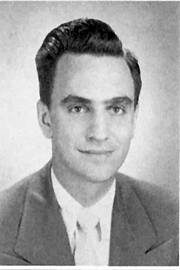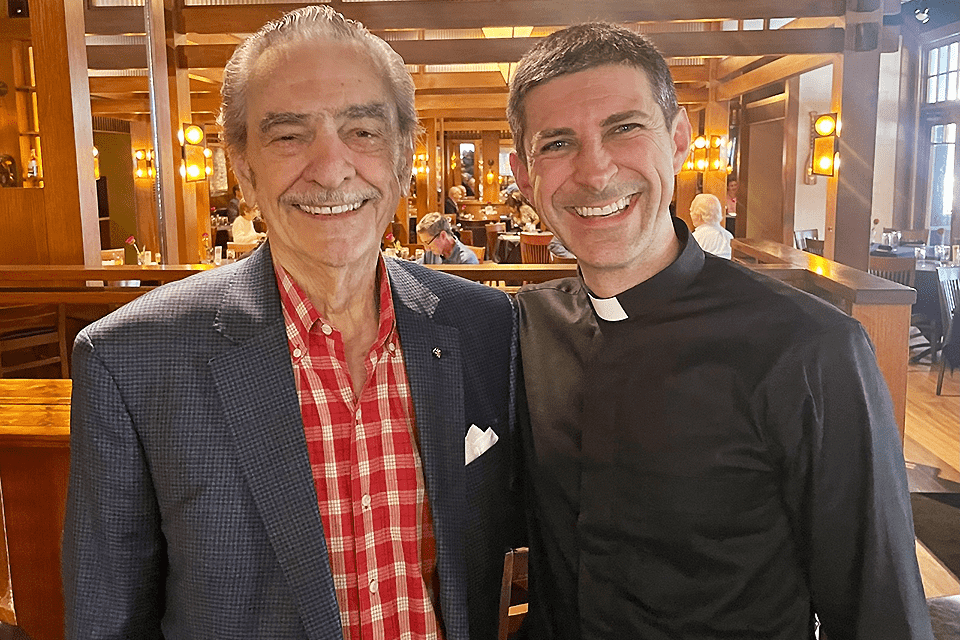Recognition Well Worth Waiting For
For Saint Louis University alumnus Al Hrubetz, waiting nearly 60 years to be publicly recognized for one of the most effectual discoveries of his career – detecting major oil reserves off the coast of Dubai – was well worth the wait.
This January, the American Association of Petroleum Geologists magazine, Explorer, published an article outlining the contributions of Al Hrubetz (PC ’53) and others to the oil discovery. Happy to be acknowledged, Hrubetz said the six-decade delay didn’t bother him. He considered his role in the process as “just another job.”
Having grown up poor during the Great Depression in the coal-mining town of Maryville, Illinois, Hrubetz was used to working from the bottom up, he said. Living in poverty meant enduring times of significant hardships, which presented him with two options: Either let the circumstances win or let adversity build strength through the moral code his mother instilled in him. He chose the latter.
From The Marine Corps to Conoco
Hrubetz served in the U.S. Marine Corps, earned a bachelor’s degree in geological engineering from Saint Louis University through the G.I. Bill, was married, started his family and was in his early 20s when Continental Oil Co. (Conoco) hired him in 1953 as a geophysicist. He was promoted to chief geophysicist, working at company headquarters in New York City, and was responsible for Conoco’s worldwide geophysical exploration activities. At that time, the industry was transitioning from coal to oil as a primary energy source. Hrubetz’s acumen in the petroleum field and his leadership prowess landed him a new position with Conoco in London as head geophysicist charged with exploring the sea floor for oil reserves off the coast of Dubai, an impoverished Middle Eastern city at that time, in what is now the United Arab Emirates.
Void of roads, electricity, plumbing and sanitation for the people living in mud huts on the sand terrain, Dubai and the untapped offshore oil field located just 60 miles off its coast remained invisible to the world. Hrubetz was about to help launch a new trajectory of global proportions.
A new method for wavefield sampling and oil detection called common-depth point (CDP) recording, also known as “horizontal stacking” or “six-fold stacking,” was gaining popularity across the industry. Conoco, a pioneer in the earlier stages of seismic exploration, designed and manufactured most of its state-of-the-art equipment to utilize the conventional technique, Hrubetz said. He and his crew received orders to solely use the company’s apparatus for their testing.
After making a few calculations, it hit me like a hammer."
Al Hrubetz (PC ’53)
Writing a New Chapter
As head geophysicist, Hrubetz knew that a prevailing northeast regional dip existed in the area, which meant that the seismic data the crew was collecting using the Conoco equipment didn’t reveal the full picture of what was hidden beneath the seafloor. While test after test detected a hard, flat sea bottom that reflected energy to the surface — a strong indicator that oil did not exist in the area — Hrubetz said he knew something was wrong with those assessments.
“After making a few calculations, it hit me like a hammer,” Hrubetz said. He concluded that multiple reflections were reverberating back and forth between the sea floor and the surface of the gulf, which meant a calcareous layer covered the floor and kept the seismic energy from penetrating it. He needed a way to suppress the strong multiple reflections and enhance the weak reflections to represent the true subsurface picture, he said.
Hrubetz’s instinct could only be proven using empirical data from the newer CDP seismic recording method. And

that presented a problem. He would have to hire another crew outside the oil company that used new equipment with a mile-long geophone cable — a rare cable length then — that could reach below the surface. It was the only way to definitively know if oil rested under the sea bottom. There was only one geophysical crew that could help.
Hrubetz was proceeding with his plan to hire the crew when he got a call from one of the leaders at Conoco, who strongly suggested that he call off his project. Shocked and disappointed, he faced a major career conundrum: Should he follow through with what he knew was correct, or should he use the findings that Conoco’s equipment produced, which by all indications eliminated the possibility of finding oil? He decided to go home to New Jersey to discern his decision with his wife Rose. They talked at length about it, he said, and she told him to do what he thought was best.
Hrubetz signed the contract with the other crew to search for the petroleum field. Once he secured all the necessary approvals, protocols and crew members, the team went to work. It took a year to drill for the oil, and the gush of petroleum off the coast of Dubai confirmed the empirical data his crew had collected. Hrubetz wrote a new historical chapter. Dubai pivoted from a city of extreme poverty to the “City of Gold” and evolved into one of the wealthiest metropolises in the world today.
Entrepreneur and Author
As a lifelong learner – a quality that Hrubetz credits SLU for fostering – he continued his education, earning a master’s in advanced management from Harvard University. His career in the oil industry flourished as he served in leadership roles that included chief executive officer of Texas Pacific Oil Corp. When the company was sold to Sun Oil, Hrubetz left to form his own enterprise, Hrubetz Oil Co., in Dallas. Years later, he tested the professional waters again, this time trying his hand at publishing. In 2006, he authored Maryville Illinois: Growing Up During the Great Depression, followed by A Geophysicist’s Memoir: Searching for Oil on Six Continents in 2017.
Now, in his 90s, the retired Marine, geophysicist and business owner is enjoying the fruits of his labor. He recalls how his favorite book he read in a theology class, In Touch with God by the Jesuit priest Bakewell Morrison, left a lasting impression on his life and solidified the moral code that he had learned as a child. Today, he continues to set aside time to enjoy all those things in life that have been worth waiting for.
Learn more about Hrubetz’s oil reserve discoveries in his book, A Geophysicist’s Memoir: Searching for Oil on Six Continents (First Edition). (2017). Dallas: MSBS Press.


















